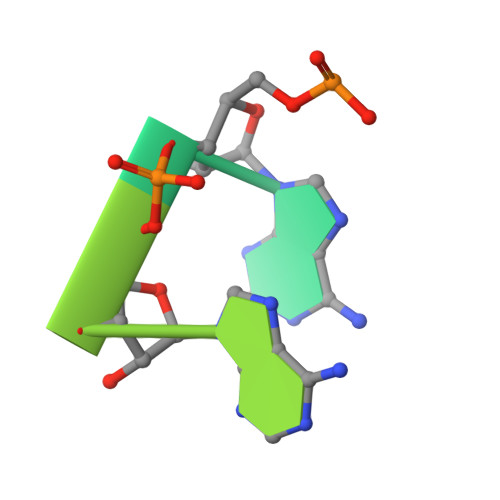Crystal structure of a poly(rA) staggered zipper at acidic pH: evidence that adenine N1 protonation mediates parallel double helix formation.
Gleghorn, M.L., Zhao, J., Turner, D.H., Maquat, L.E.(2016) Nucleic Acids Res 44: 8417-8424
- PubMed: 27288442
- DOI: https://doi.org/10.1093/nar/gkw526
- Primary Citation of Related Structures:
5K8H - PubMed Abstract:
We have solved at 1. 07: Å resolution the X-ray crystal structure of a polyriboadenylic acid (poly(rA)) parallel and continuous double helix. Fifty-nine years ago, double helices of poly(rA) were first proposed to form at acidic pH. Here, we show that 7-mer oligo(rA), i.e. rA7, hybridizes and overlaps in all registers at pH 3.5 to form stacked double helices that span the crystal. Under these conditions, rA7 forms well-ordered crystals, whereas rA6 forms fragile crystalline-like structures, and rA5, rA8 and rA11 fail to crystallize. Our findings support studies from ∼50 years ago: one showed using spectroscopic methods that duplex formation at pH 4.5 largely starts with rA7 and begins to plateau with rA8; another proposed a so-called 'staggered zipper' model in which oligo(rA) strands overlap in multiple registers to extend the helical duplex. While never shown, protonation of adenines at position N1 has been hypothesized to be critical for helix formation. Bond angles in our structure suggest that N1 is protonated on the adenines of every other rAMP-rAMP helix base pair. Our data offer new insights into poly(rA) duplex formation that may be useful in developing a pH sensor.
Organizational Affiliation:
Department of Biochemistry and Biophysics, School of Medicine and Dentistry, University of Rochester, Rochester, NY 14642, USA Center for RNA Biology, University of Rochester, Rochester, NY 14642, USA.















